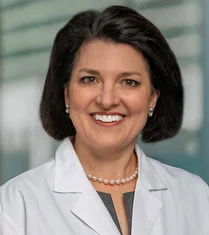


Follow us
Copyright 2024. Houston Methodist, Houston, TX. All rights reserved.
Innovative Education
A MITIESM Feat in
Maternal and
Neonatal Care
A MITIESM Feat in
Maternal and
Neonatal Care

Randolph H. Steadman, MD, MS

Stephanie S. Bruce, MD, MAS, FACOG
When Randolph H. Steadman, MD, MS, was allocated educational funds for frontline staff to train at the Houston Methodist Institute for Technology, Innovation and Education (MITIESM) at The Bookout Center, Stephanie S. Bruce, MD, MAS, FACOG, and physician champion for the Houston Methodist Women and Infants Council (WIC), jumped at the opportunity.
As a leader in simulation trainings for MITIESM at The Bookout Center and the Carole Walter Looke Centennial Chair in Anesthesia and Critical Care, Steadman is uniquely poised to lead high-fidelity simulation trainings for high-risk maternal and neonatal emergencies, such as hypertensive crises, post-partum hemorrhage and neonatal resuscitation.
Through collaboration with WIC, Steadman led MITIESM at The Bookout Center’s first Maternal and Infant Simulation Instructor Course in fall 2023. The course was well attended by physicians, nurse educators and other health care staff from all seven of Houston Methodist’s birthing hospitals.
The goal of the simulation trainings was two-fold—practice working as a team during emergencies and teach attendees how to simulate emergency scenarios for training purposes at their own entity.
Both goals would ultimately contribute to the standardization and improvement of maternal and neonatal care systemwide—a goal that dates back to 2016 when Texas implemented level of care designations for maternal and neonatal care.
“Many states are taking action against rising maternal and infant mortality rates,” Bruce explained. “When Texas first required maternal and neonatal designations, WIC began working to accomplish these level of care designations, which included implementing standardized educational trainings for physicians, nurses and other frontline staff.”
While MITIESM at The Bookout Center offers advanced technology, these resources aren’t always available in hospitals. In response, a special focus of simulation trainings became a solution for each hospital’s education and training resources. Trainees who had limited access to high-fidelity simulation resources at their home hospital could still learn how to execute an effective simulation for their staff.
“I'm just so proud of the work that we did to make simulation training more accessible for any hospital,” said Sharon Patagoc, MSN, RN. “I can't speak highly enough of Dr. Steadman’s simulation training.”
However, creating this standardized education platform proved challenging.
“We received a lot of feedback from our maternal medical directors that staff didn't want to learn virtually,” explained Sharon Patagoc, MSN, RN, WIC member and Senior Program Manager for Women Services in the Department of Quality and Patient Safety. “They really wanted to learn in a hands-on environment. This became an important consideration that led us toward simulation trainings.”
It was during the process of deciding how to accomplish these standardized simulation trainings that Dr. Steadman offered the opportunity for frontline staff to train at MITIESM at The Bookout Center, which proved to be a milestone opportunity for WIC to meet its maternal and neonatal training goals.
“Dr. Steadman did a phenomenal job teaching us how to build and execute an effective simulation,” Bruce said. “He also spent a lot of time teaching us how to effectively debrief and create psychological safety for all learners. This involves discussing how we handled the situation and what we could have done differently. Giving nurses and doctors a safe space to make a mistake and learn from it is invaluable.”
We want to make sure every nurse and doctor in our system is comfortable managing maternal and neonatal emergencies.
Sharon Patagoc, MSN, RN
In addition to learning how to work better as a team and how to simulate their own training scenarios, participants were able to identify irregularities in how each hospital responds to emergencies—a critical factor that can impact patient health outcomes.
“It was really an ‘ah-ha’ moment for us,” Bruce said. “We realized we did not have standardized color-coded emergency supply carts. What one color represented for one hospital, might represent a different emergency for another hospital.”
This lack of consistency could cause staff to mistakenly grab the wrong supply cart during an emergency, potentially delaying care in a critical situation.
“We also realized that some of our code calls, such as code stork and code pink, are different emergencies in different facilities,” Bruce continued. “We immediately recognized a need to go back to the basics and standardize our emergency supply carts and code calls.”
These discrepancies were high on the agenda during WIC’s strategic planning meeting in February.
As WIC works to standardize these discrepancies, staff continue to expand their skills through Dr. Steadman’s half-day refresher courses and by attending simulation training conferences.
Many believe the Maternal and Infant
Simulation Instructor Course
is a game changer.
“In the neonatal world, we've done a lot of simulation trainings for neonatal resuscitation, which is required every two years for nurses in childbirth centers,” explained Kayla McNeely, RN, WIC member and System Accreditation Specialist in the Department of Quality and Patient Safety. “However, having the neonatal nurses train at MITIESM at The Bookout Center and learn from Dr. Steadman was instrumental in improving the way they debrief and train their staff.”
Cristina Martin, MSN, RN, WIC Chairman and Director of the Childbirth Center at Houston Methodist Sugar Land Hospital, added, “Running these drills allows us to know what skills and education we need to work and improve upon. Other types of learning platforms, such as virtual learning, can leave knowledge gaps.”
WIC members who helped organize the trainings are adamant that Dr. Steadman’s leadership was the key to their success. They look forward to addressing further educational needs.
“We want to make sure every nurse and doctor in our system is comfortable managing maternal and neonatal emergencies,” Bruce emphasized.
Patagoc agreed, “We’re going to see better outcomes for our patients and better teamwork within our nurses and health care staff. Those who train together, stay together.”
Callie Rainosek, MS
June 2024
Related Articles
Share this story


